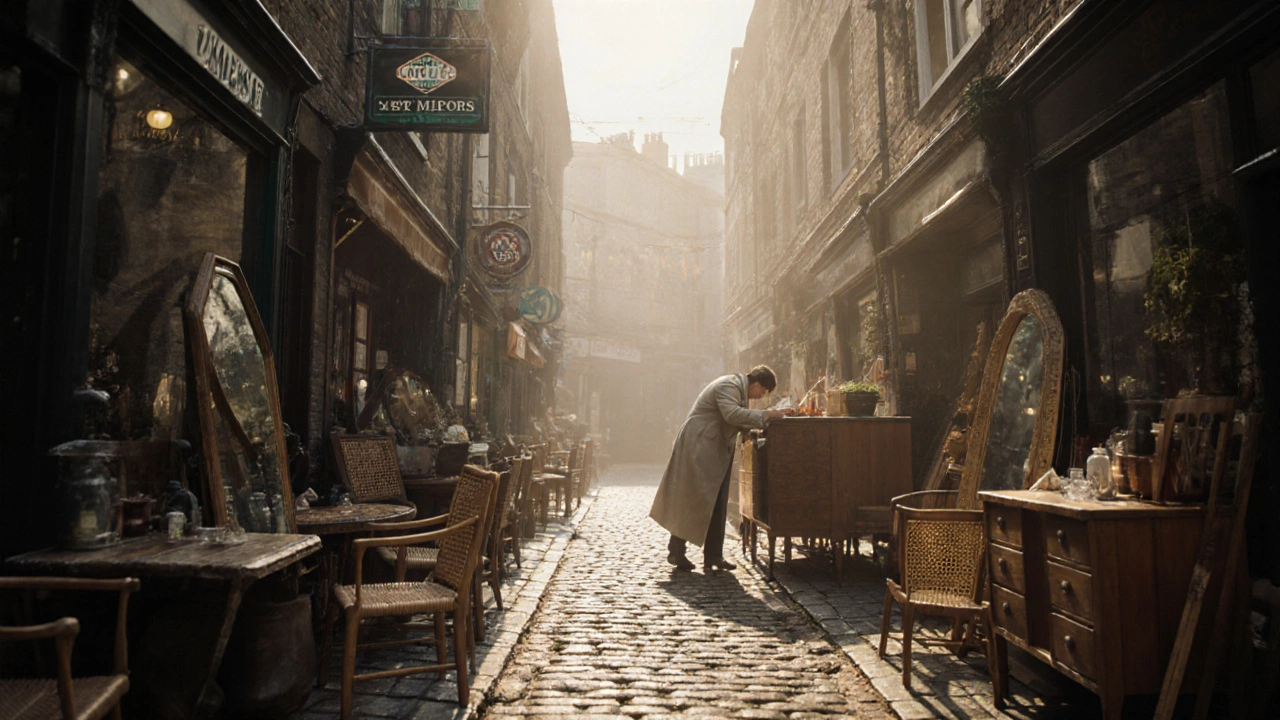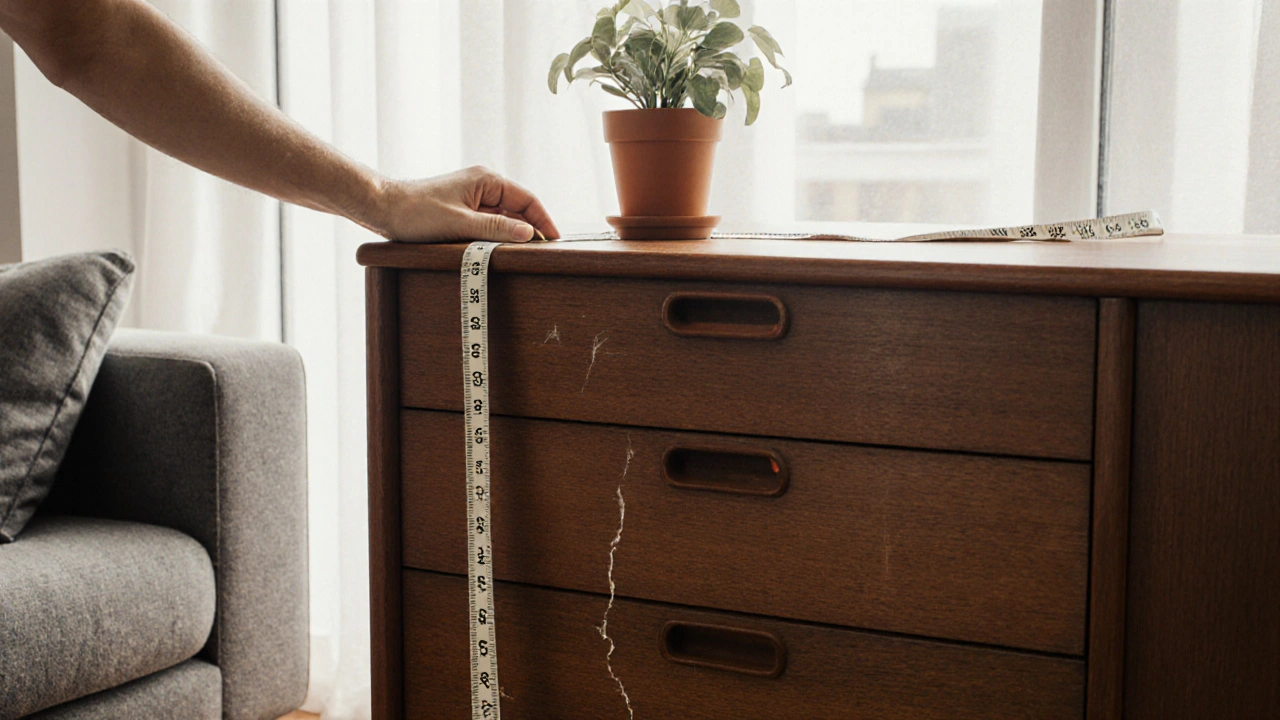
London is one of the few cities in the world where you can walk into a cluttered warehouse in Peckham and walk out with a 1950s Danish teak sideboard that still smells like cigar smoke and old leather. Vintage furniture isn’t just a trend here-it’s a habit. People don’t just buy it; they hunt for it. And if you’re looking to furnish your flat with character, not just IKEA flat-packs, you need to know where to go.
Where the Real Finds Are: London’s Top Vintage Markets
Not all markets are created equal. Some are tourist traps with overpriced reproductions. Others? They’re treasure troves where dealers sort through pallets of forgotten mid-century pieces every morning.
Camden Passage in Islington is a narrow, cobbled alley packed with independent dealers. You’ll find everything from 1920s Art Deco mirrors to 1970s rattan chairs. The key? Go early. By 11 a.m., the good stuff is already gone. Look for Antique Furniture Co. and John’s Vintage Finds-both have been here since the 90s and know their stuff. One dealer there once pulled a rare Eames lounge chair out of a skip behind a flat in Hampstead and sold it for £3,200 after a full restoration.
Portobello Road Market on Saturday mornings is the most famous, but also the most crowded. Stick to the back end near the church. That’s where the serious collectors go. You’ll find dealers with carts full of French provincial dressers and 1940s British hospital trolleys turned into coffee tables. Avoid the front stalls selling fake Louis Vuitton trunks-they’re everywhere.
Greenwich Market is quieter and more curated. It’s the place for high-quality, well-documented pieces. Look for Mid-Century Modern London-they specialize in Scandinavian and British design from 1945 to 1980. Their inventory is tagged with provenance: maker, year, and sometimes even the original owner. One table they sold last year came from a designer’s studio in Chelsea and had the original label still stuck under the leg.
Richmond Antique Centre isn’t a market-it’s a building with 30+ small shops tucked into a Georgian terrace. It’s perfect if you’re looking for something specific, like a 1930s mahogany writing desk or a set of 1960s Arne Jacobsen chairs. The staff here don’t push sales. They’ll sit you down with tea and show you photos of the piece in its original home.
Trusted Dealers: Who to Work With
Markets are great for browsing, but if you want something rare, restored, and guaranteed, go straight to the dealers. These are the names that come up again and again in London’s interior design circles.
Modern Vintage in Shoreditch has been around since 2008. They don’t just sell-they restore. Every piece they carry has been stripped, re-finished, and checked for structural integrity. Their signature? No veneer repairs. If it’s damaged, they replace the whole panel. They’ve worked with designers from Soho House and The Connaught. Expect to pay £800-£2,500 for a good piece, but you’ll get a 12-month warranty and free delivery in Zone 1.
Reclaimed London focuses on sustainability. They source everything from demolished Victorian townhouses and old school buildings. Their most popular item? Solid oak school desks from the 1920s-still with the ink stains and carved initials. They’ve got a whole warehouse in Walthamstow where you can walk through rows of doors, windows, and furniture. They’ll even help you match pieces from the same house for a cohesive look.
Old & New in Notting Hill is the quiet giant. They’ve got a small showroom, but their real inventory is online. Their website is meticulously organized by decade and material. You can filter for “teak,” “walnut,” or “upholstered.” One client found a 1957 George Nelson clock here that had been hidden under a pile of curtains in a Surrey attic. The dealer tracked it down through a family auction listing.
What to Look For (And What to Avoid)
Not every old chair is a bargain. Some are just broken. Here’s what separates a true vintage piece from a junkyard relic.
- Check the joinery. If it’s held together with nails or screws, it’s probably post-1960. Hand-cut dovetails? That’s pre-1940. Solid wood joints mean it’ll last another 50 years.
- Look for maker’s marks. Turn over drawers or lift cushions. Brands like Hille, Hans Wegner, Heal’s, and G-Plan often stamped their pieces. A G-Plan sofa from 1963 can be worth £1,800. One without a stamp? Maybe £400.
- Smell it. If it smells like mothballs or mildew, walk away. Those odors stick. A faint wood polish scent? Fine. Chemical spray? Red flag.
- Test the wobble. Sit on it. Wiggle it. A chair that creaks might be charming. One that leans to one side? Could mean rot in the legs. Don’t be afraid to ask if it’s been re-glued.
- Avoid plastic veneers. Many 1970s pieces were covered in thin plastic that peels. It’s cheap, hard to fix, and looks terrible. Stick to real wood, metal, or leather.

How to Negotiate Without Looking Like a Tourist
Dealers aren’t out to rip you off-they’re out to make a living. But they know you might not know what you’re holding.
Here’s how to haggle like a local:
- Don’t say, “Is this the best price?” Say, “I’m looking for a matching side table-do you have anything else like this?” That opens the door to a bundle deal.
- Pay cash. Many dealers prefer it. You can often knock 10-15% off if you pay on the spot.
- Ask if they’ll deliver. Most will charge £50-£120 within London. But if you’re buying three items? They’ll often throw it in.
- Go on a slow day. Tuesdays and Wednesdays are quiet. Dealers are more likely to drop prices then.
One buyer in Brixton bought a 1950s Chesterfield sofa for £600 after spotting a small tear. He said, “I’ll take it if you fix the tear and deliver it.” The dealer did. The sofa now sits in a design studio in Shoreditch and is worth £2,200.
What’s Hot Right Now (2025 Trends)
London’s vintage scene isn’t stuck in the past. Here’s what’s selling in 2025:
- British 1960s lighting. Brass floor lamps from Flos and Gubi are in high demand. Expect to pay £300-£700.
- Industrial steel shelving. Originally from factories and labs, now turned into bookshelves. Clean lines, no frills.
- Upholstered dining chairs. Not the big sofas-just the chairs. Velvet, leather, or wool. People are mixing them with modern tables.
- 1970s teak credenzas. Still the most popular storage piece. Look for ones with original handles and drawers that slide smoothly.
One thing’s clear: the market is shifting. People aren’t just buying vintage because it’s “cool.” They’re buying it because it’s durable, unique, and ethical. A 1950s oak table used for 70 years is more sustainable than five new ones from a warehouse in Poland.

Where to Start If You’re New
If you’ve never bought vintage before, start small. Don’t go for the 1930s dining set on your first trip.
- Buy a lamp. A 1960s brass floor lamp costs £120-£250 and instantly adds warmth.
- Get a side table. A 1950s teak one fits in a corner and holds your coffee and books.
- Look for one statement piece. A single chair with a great shape can anchor a whole room.
Bring a tape measure. Always. A piece that looks perfect in the market might not fit through your door. I’ve seen people cry over a beautiful dresser they couldn’t get past the staircase.
And don’t rush. The best finds come when you’re not looking. Go once a month. Talk to the dealers. They’ll remember you. And when something rare comes in? They’ll call you.
Is vintage furniture in London expensive?
It can be, but it doesn’t have to be. You can find a decent 1970s side table for £150 at a local market. High-end pieces like Eames chairs or G-Plan cabinets can cost £1,500-£4,000. But compared to buying new designer furniture, vintage often offers better quality and uniqueness for the price.
Can I find vintage furniture online in London?
Yes, but be careful. Sites like Etsy, Chairish, and Vinterior have London-based sellers, but always ask for close-up photos of joints, stains, and wear. Many dealers offer video calls to show the piece in real time. Never buy a large item without knowing its exact dimensions and condition.
How do I clean and maintain vintage furniture?
Use beeswax polish for wood-never silicone-based sprays. For upholstery, vacuum gently with a brush attachment. Avoid direct sunlight, which fades fabrics and cracks wood. If something’s loose, don’t glue it yourself. Take it to a specialist. A good restorer in London charges £40-£80 per hour.
Are there any vintage furniture fairs in London?
Yes. The London Vintage Fair happens twice a year at the Old Truman Brewery. It’s the biggest in the city, with 80+ curated dealers. You’ll find rare pieces you won’t see anywhere else. Tickets are £12, and it’s worth it if you’re serious. The next one is in March 2026.
What’s the best time of year to buy vintage furniture?
Late summer and early autumn are the sweet spots. After holidays, people clear out homes and sell off furniture. Dealers get fresh stock. Winter is slow, so prices dip. Avoid January-everyone’s broke after Christmas, and dealers mark things up to compensate.
Final Tip: Trust Your Gut, Not the Price Tag
The most expensive piece in the room isn’t always the best. I once passed on a £900 teak dresser because it had a scratch. A week later, I saw the same one at a stall for £250. The dealer said, “It’s got character. That scratch? That’s where a kid used to draw on it.” I bought it. Now it’s the centerpiece of my dining room.
Vintage furniture isn’t about perfection. It’s about stories. And in London, every piece has one.